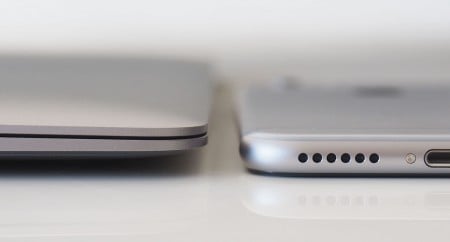Long term, however, we found the keyboard to be surprisingly comfortable, and the MacBook has one of those keyboards that grows on you over time.
We spent a fair amount of that time working on a novel, and after several thousand words, found the keys really did feel good, with just enough travel to feel like real keys, even if the mechanism was different and the sound was closer to us typing on an iPad keyboard with a slightly different and higher pitched click.
Whether it was spending its time on a wooden desk or on our lap, the keys felt sound, and that slim travel was just enough to make us not feel as if we were striking our fingers on wood or metal, which slim keyboards can often resemble.
This helped us to type with speed, and our error rate was practically nil, only popping up for air every so often when the Force trackpad did the same thing that it was doing on the MacBook Pro review and forcing our cursor somewhere else when our palm touched the trackpad a little too much, something we don’t get on Apple’s conventional generic trackpad on the MacBook Air.
That Force trackpad is still a very cool thing, despite that little bug (and we’re now learning to keep our palms well and truly away the trackpad as we type), with no real button, and only a semblance of haptic movement tricking you into thinking there’s movement there.
Apple has now told us how this little trick works, and it’s quite cool: rather than provide the typical haptic vibration resistance against the back of the button, the trackpad moves a very, very, very, very, very small distance left and right, tricking your finger (and your brain) into thinking that this is a clicking response.
Because this is just a type of vibration, it can be tightened and configured, making it possible for you to push it lightly for one click, and push it down harder for a full secondary click, and it’s this secondary click — the “Force” click, as Apple calls it — that can offer different functionality, offering definitions of words, maps of locations in your email or websites, or even just giving you previews of files (which the space bar can also do in Mac OS X).
Thankfully, the Force trackpad can be controlled, with loosening or tightening offered, and even the ability to switch it off, meaning you can use the computer in this new modern way if you so choose, or don’t and forget about it altogether, which is totally your choice.
We left it on and made the action firmer, making us press down harder if we wanted to use the Force click, but everyone will be different, and Apple tells us there’s a fair amount of pressure sensitivity for the trackpad, evident if you put your finger down gradually on a file before you hit the second deeper click, which will result in little files growing in animation.
Aside for these things, you’ll also find backlighting that has been firmed up and is now tighter with several levels of backlighting (we saw 16), and even though this is a first generation product, the new keyboard and new mouse (which we’ve seen once before) don’t feel like they’re equally first generation, just a little more refined.
We still think better drivers will clear up the trackpad’s confusion on our wrist pad, but the keyboard is very impressive for something so new.
Battery life is also surprising here, because this is a remarkably thin computer, and yet it achieves battery life comparable to machines that are far thicker, with around 6 to 7 hours of performance likely.
There are some things Apple has had to do to get these sorts of levels, and we suspect the low-performance Intel Core M has a lot to do with this, as does Mac OS X 10.10 “Yosemite”, but there’s more to it, and there’s a degree of improved battery technology here, with a layered battery used inside the casing.
In the MacBook — this specific MacBook — Apple has decided to take advantage of all the space it has, because it has so much to work with now that the computer itself is so small, and when we say “the computer itself”, we mean all the bits and bobs that make this computer go, the guts, the chip, the processor, the stuff that makes it more than a screen, a keyboard, a mouse, and a battery.
That equipment is now very small and fan-less, and sits closer to the back of the computer than the front, with the rest of the chassis space made available for a battery.

As a result, Apple has decided to layer the battery, a concept that is similar to what LG did with its G2 smartphone, resulting in a battery that wasn’t removable, but was built to take advantage of the curved form near the base of the unit, meaning it could fill the spaces provided rather than provide the conventional “block with space left” design that most batteries in most devices rely on.
Apple’s take on this is a little different, with a battery that isn’t just a block, but rather made from layering, resulting in 35 percent more captive it and more of the metal unibody case having a battery inside.
This helps you get the most out of the machine, and if Apple had left this area the same as it does on the other MacBook Pro or Air models, we’d probably seen an hour or two less.
Finally, there’s that USB port, and this is both a positive and a negative thing on our first-generation MacBook machine.
For now, we’ll start with the positives, because they’re easy: you have one port that provides power, data, and video.
This is the way USB should be, providing everything you need through one outlet. Easy.












